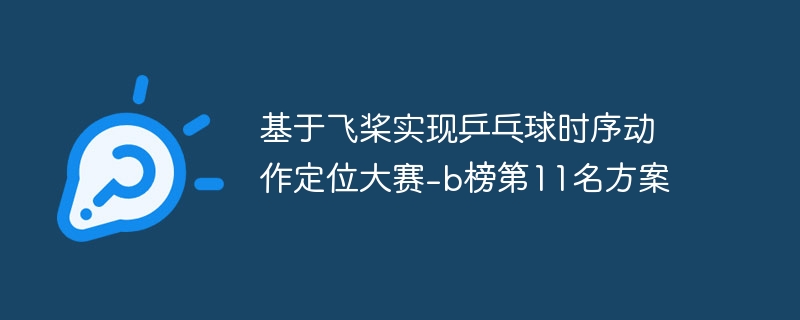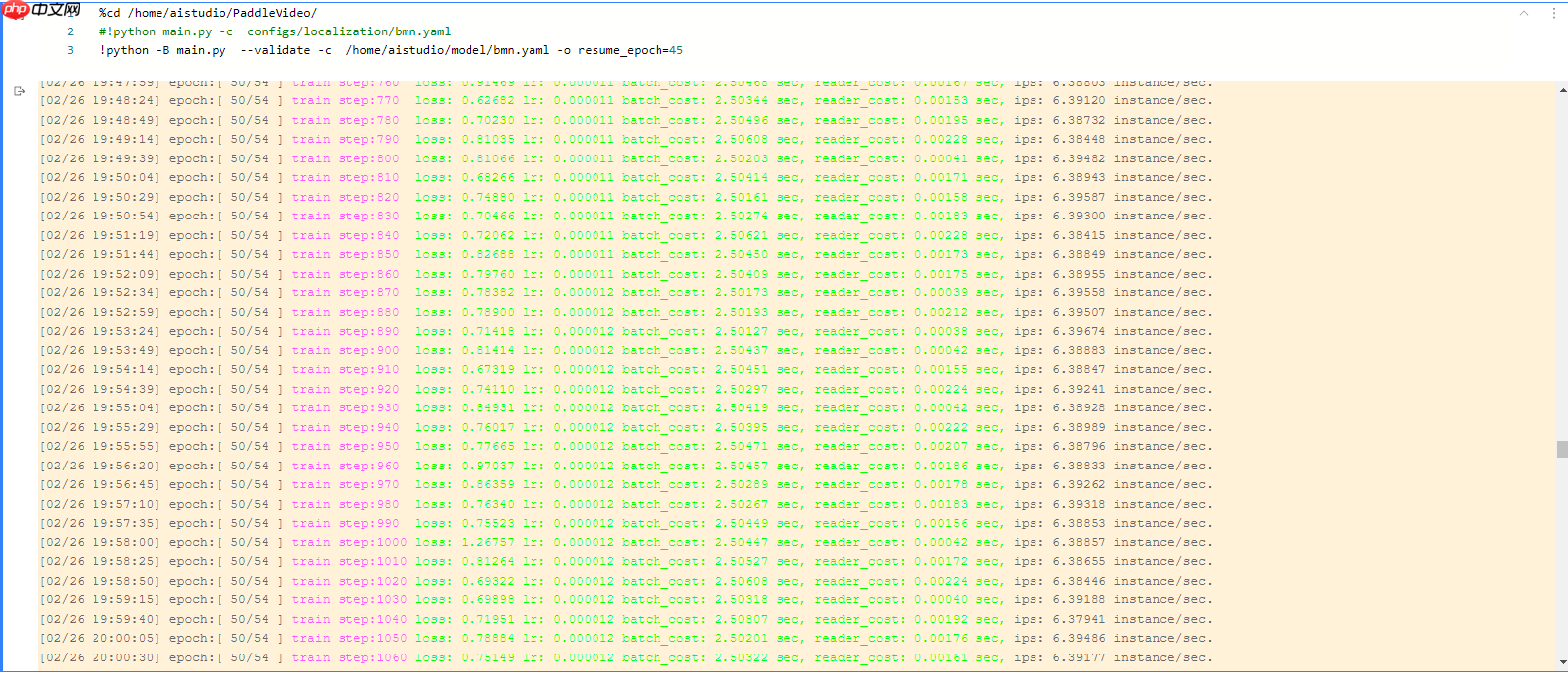该方案基于飞桨PaddleVideo的BMN模型,优化乒乓球时序动作定位。先分析训练集label分布与动作时长,参考Football Vocation调整窗口大小,分割数据为9:1的训练、验证集。训练尝试多种策略,用CustomWarmupCosineDecay提升分数,最终导出模型推理,生成提交文件,获B榜第11名。
☞☞☞AI 智能聊天, 问答助手, AI 智能搜索, 免费无限量使用 DeepSeek R1 模型☜☜☜

本方案基于数个基线方案和PaddleVIdeo官方代码仓进行优化
reference:
使用Paddle实现乒乓球时序动作定位开源方案
使用Football Vocation 分割数据实现乒乓球时序动作定位
数据集的处理:首先通过观察训练集的label分布,研究了动作的平均时长分布;
之后参考了Football Vocation的处理方法,调整窗口大小;
训练:尝试了余弦退火等多种策略,不同的学习率和warmup策略;
尝试了不同的epochs数量。
在众多大规模视频分析情景中,从冗长未经修剪的视频中定位并识别短时间内发生的人体动作成为一个备受关注的课题。当前针对人体动作检测的解决方案在大规模视频集上难以奏效,高效地处理大规模视频数据仍然是计算机视觉领域一个充满挑战的任务。其核心问题可以分为两部分,一是动作识别算法的复杂度仍旧较高,二是缺少能够产生更少视频提案数量的方法(更加关注短时动作本身的提案)。
这里所指的视频动作提案是指一些包含特定动作的候选视频片段。为了能够适应大规模视频分析任务,时序动作提案应该尽可能满足下面两个需求: (1)更高的处理效率,例如可以设计出使时序视频片段编码和打分更高效的机制; (2)更强的判别性能,例如可以准确定位动作发生的时间区间。
本次比赛旨在激发更多的开发者和研究人员关注并参与有关视频动作定位的研究,创建性能更出色的动作定位模型。
本次比赛的数据集包含了19-21赛季兵乓球国际比赛(世界杯、世锦赛、亚锦赛,奥运会)和国内比赛(全运会,乒超联赛)中标准单机位高清转播画面的特征信息,共包含912条视频特征文件,每个视频时长在0~6分钟不等,特征维度为2048,以pkl格式保存。我们对特征数据中面朝镜头的运动员的回合内挥拍动作进行了标注,单个动作时常在0~2秒不等,训练数据为729条标注视频,A测数据为91条视频,B测数据为92条视频,训练数据标签以json格式给出。
本方案采用PaddleVideo中的BMN模型。BMN模型是百度自研,2019年ActivityNet夺冠方案,为视频动作定位问题中proposal的生成提供高效的解决方案,在PaddlePaddle上首次开源。此模型引入边界匹配(Boundary-Matching, BM)机制来评估proposal的置信度,按照proposal开始边界的位置及其长度将所有可能存在的proposal组合成一个二维的BM置信度图,图中每个点的数值代表其所对应的proposal的置信度分数。网络由三个模块组成,基础模块作为主干网络处理输入的特征序列,TEM模块预测每一个时序位置属于动作开始、动作结束的概率,PEM模块生成BM置信度图。
本赛题中的数据包含912条ppTSM抽取的视频特征,特征保存为pkl格式,文件名对应视频名称,读取pkl之后以(num_of_frames, 2048)向量形式代表单个视频特征。其中num_of_frames是不固定的,同时数量也比较大,所以pkl的文件并不能直接用于训练。同时由于乒乓球每个动作时间非常短,为了可以让模型更好的识别动作,所以这里将数据进行分割。
%cd /home/aistudio/data/ !wget https://bj.bcebos.com/v1/ai-studio-online/a34561eb976644e79808072528bf6d8bccb3f8d0b20a4d7499af0db282e01d87 -O Features_competition_test_B.tar.gz !tar xf Features_competition_test_B.tar.gz !tar xf data122998/Features_competition_train.tar.gz !tar xf data123004/Features_competition_test_A.tar.gz !cp data122998/label_cls14_train.json . !rm -rf data12*
import osimport sysimport jsonimport randomimport pickleimport numpy as np
2.下面对数据进行一些分析和观察
source_path = "/home/aistudio/data/label_cls14_train.json"
import jsonwith open('/home/aistudio/data/label_cls14_train.json') as f:
data = json.load(f)
f.close()dura = []for i in range(len(data['gts'])): for j in range(len(data['gts'][i]['actions'])): # print(i)
# print(j)
dura.append(data['gts'][i]['actions'][j]['end_id']-data['gts'][i]['actions'][j]['start_id'])观察数据的分布,发现平均值为0.74,最大值为33
import numpy as npimport pandas as pdimport matplotlib.pyplot as pltimport seaborn as sb %matplotlib inline df = pd.DataFrame(dura) df.describe()
0 count 19054.000000 mean 0.735617 std 0.510685 min 0.040000 25% 0.480000 50% 0.600000 75% 0.840000 max 33.200000
可视化数据分布
sb.distplot(dura, color="b", bins=20, rug=True) sb.distplot(dura, hist=False)
<matplotlib.axes._subplots.AxesSubplot at 0x7f932fc88310>
<Figure size 432x288 with 1 Axes>
去除大于4的数值后的分布
mid = df.median() df[(df>4)] = np.nan df.fillna(mid,inplace=True) df.describe() sb.distplot(df, color="b", bins=20, rug=True) sb.distplot(df, hist=False)
<matplotlib.axes._subplots.AxesSubplot at 0x7f9305d8f050>
<Figure size 432x288 with 1 Axes>
#按照9:1划分训练 测试集l=len(data['gts'])
l=int(l*0.1)
val = {'gts': data['gts'][0:l], 'fps': 25}
jsonString = json.dumps(val, indent=4, ensure_ascii=False)
jsonFile = open('/home/aistudio/data/label_cls14_val.json', 'w')
jsonFile.write(jsonString)
jsonFile.close()
train = {'gts': data['gts'][l:], 'fps': 25}
jsonString = json.dumps(train, indent=4, ensure_ascii=False)
jsonFile = open('/home/aistudio/data/label_cls14_train.json', 'w')
jsonFile.write(jsonString)
jsonFile.close()"""
get instance for bmn
使用winds=4的滑窗,将所有子窗口的长度之和小于winds的进行合并
合并后,父窗口代表bmn训练数据,子窗口代表tsn训练数据
"""import osimport sysimport jsonimport randomimport pickleimport numpy as npimport math# for table tennisbmn_window = 4dataset = "/home/aistudio/data"feat_dir = dataset + '/Features_competition_train'out_dir = dataset + '/Input_for_bmn'label_files = { 'train': 'label_cls14_train.json', 'validation': 'label_cls14_val.json'}global fpsdef gen_gts_for_bmn(gts_data):
"""
@param, gts_data, original gts for action detection
@return, gts_bmn, output gts dict for bmn
"""
fps = gts_data['fps']
gts_bmn = {'fps': fps, 'gts': []} for sub_item in gts_data['gts']:
url = sub_item['url']
max_length = sub_item['total_frames']
gts_bmn['gts'].append({ 'url': url, 'total_frames': max_length, 'root_actions': []
})
sub_actions = sub_item['actions'] # 跳过没有动作的片段
if len(sub_actions) == 0: continue
# duration > bmn_window, 动作持续时间大于bmn_windows,直接删除
for idx, sub_action in enumerate(sub_actions): if sub_action['end_id'] - sub_action['start_id'] > bmn_window:
sub_actions.pop(idx) # 【滑动窗口,把每一个视频里的动作片段提取出来】
root_actions = [sub_actions[0]] # before_id, 前一动作的最后一帧
# after_id, 后一动作的第一帧
before_id = 0
for idx in range(1, len(sub_actions)):
cur_action = sub_actions[idx]
duration = (cur_action['end_id'] - root_actions[0]['start_id']) if duration > bmn_window: # windows只能包住一个动作就包,包不住就包多个
after_id = cur_action['start_id']
gts_bmn['gts'][-1]['root_actions'].append({ 'before_id':
before_id, 'after_id':
after_id, 'actions':
root_actions
})
before_id = root_actions[-1]['end_id'] #更新滑窗
root_actions = [cur_action] else:
root_actions.append(cur_action) if idx == len(sub_actions) - 1:
after_id = max_length
gts_bmn['gts'][-1]['root_actions'].append({ 'before_id':
before_id, 'after_id':
after_id, 'actions':
root_actions
}) return gts_bmndef combile_gts(gts_bmn, gts_process, mode):
"""
1、bmn_window 范围内只有一个动作,只取一个目标框
2、bmn_window 范围内有多个动作,取三个目标框(第一个动作、最后一个动作、所有动作)
"""
global fps
fps = gts_process['fps']
duration_second = bmn_window * 1.0
duration_frame = bmn_window * fps
feature_frame = duration_frame for item in gts_process['gts']:
url = item['url']
basename = os.path.basename(url).split('.')[0]
root_actions = item['root_actions'] # 把每一个视频里的动作片段提取出来
for root_action in root_actions:
segments = [] # all actions
segments.append({ 'actions': root_action['actions'], 'before_id': root_action['before_id'], 'after_id': root_action['after_id']
}) if len(root_action['actions']) > 1: #如果有多个动作,则第一个动作和最后一个动作,额外添加一次
# first action
segments.append({ 'actions': [root_action['actions'][0]], 'before_id':
root_action['before_id'], 'after_id':
root_action['actions'][1]['start_id']
}) # last action
segments.append({ 'actions': [root_action['actions'][-1]], 'before_id':
root_action['actions'][-2]['end_id'], 'after_id':
root_action['after_id']
}) # 把动作片段处理成window size大小,以适配BMN输入
for segment in segments:
before_id = segment['before_id']
after_id = segment['after_id']
actions = segment['actions'] # before_id到after_id太长了,从里面取window_size帧,要先确定一个起始点,然后动作都要包住
box0 = max(actions[-1]['end_id'] - bmn_window,
before_id) #确定起始点
box1 = min(actions[0]['start_id'],
after_id - bmn_window) #确实起始点
if box0 <= box1: # 一次检查
if int(box0) - int(box1) == 0:
cur_start = box0 else:
box0 = math.ceil(box0)
box1 = int(box1)
cur_start = random.randint(box0, box1)
cur_end = cur_start + bmn_window
cur_start = round(cur_start, 2)
cur_end = round(cur_end, 2)
name = '{}_{}_{}'.format(basename, cur_start, cur_end)
annotations = [] for action in actions:
label = str(1.0 * action['label_ids'][0])
label_name = action['label_names'][0]
seg0 = 1.0 * round((action['start_id'] - cur_start), 2) #存储的是到开始位置(时间: s)的距离
seg1 = 1.0 * round((action['end_id'] - cur_start), 2)
annotations.append({ 'segment': [seg0, seg1], 'label': label, 'label_name': label_name
})
gts_bmn[name] = { 'duration_second': duration_second, 'duration_frame': duration_frame, 'feature_frame': feature_frame, 'subset': mode, 'annotations': annotations
} return gts_bmndef save_feature_to_numpy(gts_bmn, folder):
global fps print('save feature for bmn ...') if not os.path.exists(folder):
os.mkdir(folder)
process_gts_bmn = {}
miss = 0
for item, value in gts_bmn.items(): # split to rsplit 针对文件命名修改
basename, start_id, end_id = item.rsplit('_', 2) if not basename in process_gts_bmn:
process_gts_bmn[basename] = []
process_gts_bmn[basename].append({ 'name': item, 'start': float(start_id), 'end': float(end_id)
}) for item, values in process_gts_bmn.items():
feat_path = os.path.join(feat_dir, item + '.pkl')
feature_video = pickle.load(open(feat_path, 'rb'))['image_feature'] for value in values:
save_cut_name = os.path.join(folder, value['name'])
a, b, c = save_cut_name.rsplit('_', 2) if float(b) > 360: print(b)
start_frame = round(value['start'] * fps)
end_frame = round(value['end'] * fps) if end_frame > len(feature_video):
miss += 1
continue
feature_cut = [
feature_video[i] for i in range(start_frame, end_frame)
]
np_feature_cut = np.array(feature_cut, dtype=np.float32)
np.save(save_cut_name, np_feature_cut) print('miss number (broken sample):', miss)if __name__ == "__main__": if not os.path.exists(out_dir):
os.mkdir(out_dir)
gts_bmn = {} for item, value in label_files.items():
label_file = os.path.join(dataset, value)
gts_data = json.load(open(label_file, 'rb'))
gts_process = gen_gts_for_bmn(gts_data)
gts_bmn = combile_gts(gts_bmn, gts_process, item) with open(out_dir + '/label.json', 'w', encoding='utf-8') as f:
data = json.dumps(gts_bmn, indent=4, ensure_ascii=False)
f.write(data)
save_feature_to_numpy(gts_bmn, out_dir + '/feature')import copyimport jsonimport reimport os
url = '/home/aistudio/data/Input_for_bmn/feature/'directory = os.fsencode(url)
count = 0target_set = []for file in os.listdir(directory):
filename = os.fsdecode(file)
target_name = filename.split('.npy')[0]
target_set.append(target_name)
count += 1print('Feature size:', len(target_set))with open('/home/aistudio/data/Input_for_bmn/label.json') as f:
data = json.load(f)
delet_set = []for key in data.keys(): if not key in target_set:
delet_set.append(key)print('(Label) Original size:', len(data))print('(Label) Deleted size:', len(delet_set))for item in delet_set:
data.pop(item, None)print('(Label) Fixed size:', len(data))
jsonString = json.dumps(data, indent=4, ensure_ascii=False)
jsonFile = open('/home/aistudio/data/Input_for_bmn/label_fixed.json', 'w')
jsonFile.write(jsonString)
jsonFile.close()执行完毕后,在data/Input_for_bmn/目录中生成了新的标注文件label_fixed.json。同时删除不必要的原始文件,降低空间占用
!rm /home/aistudio/data/Features_competition_train/*.pkl
执行后在data/Features_competition_train/npy目录下生成了训练用的numpy数据。
import osimport os.path as ospimport globimport pickleimport paddleimport numpy as np
file_list = glob.glob("/home/aistudio/data/Features_competition_test_A/*.pkl")
max_frames = 9000npy_path = ("/home/aistudio/data/Features_competition_test_A/npy/")if not osp.exists(npy_path):
os.makedirs(npy_path)for f in file_list:
video_feat = pickle.load(open(f, 'rb'))
tensor = paddle.to_tensor(video_feat['image_feature'])
pad_num = 9000 - tensor.shape[0]
pad1d = paddle.nn.Pad1D([0, pad_num])
tensor = paddle.transpose(tensor, [1, 0])
tensor = paddle.unsqueeze(tensor, axis=0)
tensor = pad1d(tensor)
tensor = paddle.squeeze(tensor, axis=0)
tensor = paddle.transpose(tensor, [1, 0])
sps = paddle.split(tensor, num_or_sections=90, axis=0) for i, s in enumerate(sps):
file_name = osp.join(npy_path, f.split('/')[-1].split('.')[0] + f"_{i}.npy")
np.save(file_name, s.detach().numpy()) pass数据集分割好之后,可以开始训练模型,使用以下命令进行模型训练。首先需要安装PaddleVideo的依赖包。
# 从Github上下载PaddleVideo代码!git clone https://github.com/PaddlePaddle/PaddleVideo.git
%cd /home/aistudio/PaddleVideo/ !pip install -r requirements.txt
开始训练模型
config文件位于/home/aistudio/model/bmn.yaml
训练时的恢复训练这一参数参考了官方repo,需要在训练时指定 -o参数,同时在config文件中指定resume_from的模型权重位置
训练截图:

最终用于比赛提交的模型权重是第50个,位置是/home/aistudio/model/BMN_epoch_00050.pdparams
训练时采用了不同的batdch_size策略,提升不大
采用了不同的学习率策略:https://github.com/PaddlePaddle/PaddleVideo/blob/develop/paddlevideo/solver/custom_lr.py
使用CustomWarmupCosineDecay比直接decay的a榜分数提高了0.5左右
%cd /home/aistudio/PaddleVideo/#!python main.py -c configs/localization/bmn.yaml!python -B main.py --validate -c /home/aistudio/model/bmn.yaml -o resume_epoch=45
将训练好的模型导出用于推理预测,执行以下脚本。
%cd /home/aistudio/PaddleVideo/ !python tools/export_model.py -c configs/localization/bmn.yaml -p /home/aistudio/model/BMN_epoch_00050.pdparams -o inference/BMN
使用导出的模型进行推理预测,执行以下命令。
%cd /home/aistudio/PaddleVideo/# !python tools/predict.py --input_file /home/aistudio/data/Features_competition_test_A/npy \!python tools/predict.py --input_file /home/aistudio/data/Features_competition_test_B/npy \ --config configs/localization/bmn.yaml \ --model_file inference/BMN/BMN.pdmodel \ --params_file inference/BMN/BMN.pdiparams \ --use_gpu=True \ --use_tensorrt=False
上面程序输出的json文件是分割后的预测结果,还需要将这些文件组合到一起。执行以下脚本:
import osimport jsonimport glob# json_path = "/home/aistudio/data/Features_competition_test_A/npy/"json_path = "/home/aistudio/data/Features_competition_test_B/npy/"json_files = glob.glob(os.path.join(json_path, '*_*.json'))
submit_dic = {"version": None, "results": {}, "external_data": {}
}
results = submit_dic['results']for json_file in json_files:
j = json.load(open(json_file, 'r'))
old_video_name = list(j.keys())[0]
video_name = list(j.keys())[0].split('/')[-1].split('.')[0]
video_name, video_no = video_name.split('_')
start_id = int(video_no) * 4
if len(j[old_video_name]) == 0: continue
for i, top in enumerate(j[old_video_name]): if video_name in results.keys():
results[video_name].append({'score': round(top['score'], 2), 'segment': [round(top['segment'][0] + start_id, 2), round(top['segment'][1] + start_id, 2)]}) else:
results[video_name] = [{'score':round(top['score'], 2), 'segment': [round(top['segment'][0] + start_id, 2), round(top['segment'][1] + start_id, 2)]}]
json.dump(submit_dic, open('/home/aistudio/submission.json', 'w', encoding='utf-8'))最后会在用户目录生成submission.json文件,压缩后下载提交即可。
%cd /home/aistudio/ !zip submission.zip submission.json
/home/aistudio adding: submission.json (deflated 91%)
以上就是基于飞桨实现乒乓球时序动作定位大赛-b榜第11名方案的详细内容,更多请关注php中文网其它相关文章!

每个人都需要一台速度更快、更稳定的 PC。随着时间的推移,垃圾文件、旧注册表数据和不必要的后台进程会占用资源并降低性能。幸运的是,许多工具可以让 Windows 保持平稳运行。

Copyright 2014-2025 https://www.php.cn/ All Rights Reserved | php.cn | 湘ICP备2023035733号